Quite some time ago, I did an item on the “capital to labor ratio.”
March 30, 2008: The Capital/Labor Ratio
Can you believe that was over three years ago? This is actually one of the most important points of practical economics, I think, since it directly affects everything that we’re most concerned about: productivity, unemployment, wages, income disparities, (the need for) welfare spending, and so forth.
It is also particularly pertinent today, since we are suffering from capital/labor ratio problems today. The development of efficient transportation systems (container shipping), information systems, and various political developments, has resulted in a huge amount of new labor introduced on the world markets. I’m talking about China, India and so forth here. This is actually a continuation of something that has been going on for a very long time. British workers complained about competition from newly introduced low-wage labor from Latin America and India in the late 19th century. Indeed, one of the effects of the British Empire was to incorporate these low-wage areas by giving them a superstructure of British law, politics, regulation, banking and so forth, which allowed British industrialists to invest in these areas. Plus, the Empire was a free-trade area. Capitalists loved it, British workers, not so much.
On top of this introduction of low-priced new labor, we have the continuous introduction of more labor via simple population growth. (This includes immigration.)
1790 3,929,214
—
1800 5,236,631 33.3%
1810 7,239,881 38.3%
1820 9,638,453 33.1%
1830 12,866,020 33.5%
1840 17,069,453 32.7%
1850 23,191,876 35.9%
1860 31,443,321 35.6%
1870 38,558,371 22.6%
1880 49,371,340 28.0%
1890 62,979,766 27.6%
1900 76,212,168 21.0%
1910 92,228,496 21.0%
1920 106,021,537 15.0%
1930 123,202,624 16.2%
1940 132,164,569 7.3%
1950 151,325,798 14.5%
1960 179,323,175 18.5%
1970 203,211,926 13.3%
1980 226,545,805 11.5%
1990 248,709,873 9.8%
2000 281,421,906 13.2%
2010 308,745,538 9.7%
Look at that. 30%+ population growth per decade. Where did all those people find jobs?
Capitalism, you could say, is actually quite fair. It doesn’t care whether you’re a white American or a Chinese. It spreads the money around evenly. Not only wages, but also capital investment. Capital investment has been huge in China, which is leading to leaps and bounds in Chinese productivity, and rapidly rising wages.
Where do jobs come from? You could say that it is the flip side of investment. In general, you don’t need more people to do what you are already doing. If it takes 10,000 people to make 50,000 cars per year, then you don’t need to hire another 5,000 people to make the same 50,000 cars. If anything, the trend is the other way. Due to incremental improvements, you might end up needing 8,000 people to make the same 50,000 cars per year. This is the incremental improvement in productivity which leads to rising GDP.
However, you don’t have a rising GDP and productivity unless those extra 2,000 people have something new to do. For example, if you have 10,000 people to make 50,000 cars, and then you have 8,000 people to make 50,000 cars, and 2,000 unemployed people, then your productivity is unchanged. At the end of the year, you have 10,000 people, and 50,000 cars. Actually, you have a new problem of unemployment and distribution of income. The production is the same, but 8,000 people get all the benefit and 2,000 people get nothing.
We have the opportunity to put those 2,000 unemployed to work in some way. Let’s say they become highly-trained restaurant cooks. Now we have 50,000 cars per year, plus the output of 2,000 restaurant cooks. The society has become wealthier. I am assuming that these are relatively high-paid restaurant jobs (not fast food), so we now have low unemployment and ample wages again. Everybody is happy, because they all have cars and also they can eat out once a week.
I am using restaurant cooks as an example of a service industry. We have way too many factories-making-cars metaphors and examples these days. The economy is actually mostly services already, and trending further in that direction.
May 16, 2010: The Service Economy
September 19, 2010: The Service Economy 2: It’s Already Here
But where do those restaurant jobs come from? And, how do we get high-paid, high-quality restaurant jobs, rather than low-paid/low-quality jobs?
Today, we think of service jobs as being “low quality,” but that is in large part due to the capital/labor ratio issues we are discussing. We associate manufacturing jobs with “high quality” jobs but that is not necessarily the case. A high quality/high paid manufacturing job is one in which there are relatively few people making high-value products. Like airplanes perhaps. You can also have manufacturing which involves large numbers of people making low-value products, which we call a “sweatshop.” Shoe manufacturing, for example. We also have high-value service jobs, notably in healthcare these days.
In our example, those restaurant jobs come from someone investing money to make a new restaurant. You have to lease a location, decorate it, buy equipment, advertise and so forth, all capital put at risk. Then you hire people to get your new venture going. This could be a small business, but it can also be a large company that is expanding. In general, the more capital that is involved, the higher-paid/higher productivity the jobs are. In the olden days, we used to say that you would replace one person with a shovel with one person with a backhoe. The backhoe represents much more capital than the shovel, and correspondingly makes the digger more productive. These “shovel/backhoe” examples have become so antiquarian today that they don’t really describe what is happening in the real economy anymore. In the case of something like a hotel, we can also see that you can make a luxury hotel with 100 employees (backhoe), or a cheapie motel with 100 employees (shovel). We could have a nice sit-down restaurant (backhoe) or a fast-food shack (shovel). The luxury hotel would cost a lot more to make (more capital), and the resulting service (hotel services) would have higher value. Thus, the employees become more productive, because the same 100 people are now offering high-value services rather than low-value ones.
However, as we know, lots of the jobs for even high-end hotels are not well paid. Even if the backhoe operator can dig vastly more quickly than a shovel digger, his wages do not necessarily rise in proportion to this huge increase in productivity. Why is that? It is in part because of the general surplus of labor. Let’s say that you have those 2,000 unemployed people. You have one high-end hotel that is hiring 100 employees, two cheapie motels that are hiring 200 employees, and 1,700 people who will not end up with a job. As you can see, the high-end hotel doesn’t have to pay very much more than the low-end hotel. The marginal cost of labor is low because there is relatively little demand for the supply. Where does the extra productivity go — the output of the high-end hotel? It goes to capitalists and upper management, for the most part.
However, let’s say there are thirty people who want to open high-end hotels. In other words, we have a lot of capital for investment, enough to open thirty hotels. Each person wants 100 employees, or 3,000 total, but there are only 2,000 available. Thus, wages tend to get bid higher, so that more of the benefit (the output of the new hotels) goes to the employees, and less to capital and upper management. Also, everyone gets a job.
What happens to those 10 people who want to open a hotel but can’t get the employees? They have to find a new business which has higher productivity (fewer people/greater output) and pays higher wages. For example, let’s say those 100 hotel employees can create goods and services worth $3,000,000. Thus, the production is $3,000,000/100 or $30,000 per person. However, let’s say there’s a new business, as software engineers, where you have 50 employees that create services worth $3,000,000. Now, the production is $3,000,000/50 or $60,000 per person. The capitalist can now offer higher wages, outbidding the hotel investors for employees. Consequently, the productivity of employees also rises.
What does this look like at the lowest end? Someone needs to clean the toilets. They don’t clean themselves. If the toilet cleaner has the option of working in a factory for $20 an hour, then the wage for a toilet cleaner will have to be around $20. However, if the alternative is unemployment, then the employer can get away with paying the toilet cleaner minimum wage. The difference is the factory — plentiful capital competing for scarce labor.
These principles apply even to the self-employed. A self-employed person has to invest in education (for an accountant or a lawyer), or invest in a store, or a restaurant, or auto-body shop, or buy land if they are a farmer, or whatever.
So, I am trying to introduce a few basic principles:
2) Jobs come from capital investment.
3) When capital is plentiful and labor is scarce, wages tend to be bid higher and income disparities shrink.
With all this in mind, you might think that it would be important to have as much capital investment as possible. In the 19th century, “capital creation” was a major focus of their economic thinking. John Stuart Mill’s Priciples of Political Economy (1848) — be sure to get the unabridged version — has many chapters devoted to the topic. Today, almost nobody thinks about it. We think we can solve unemployment with monetary fiddling.
Obviously, this all affects government spending as well. When you have fewer unemployed, and those employed have higher-paid jobs, then you have a lot less need for government-provided welfare services.
Let’s think about what is happening, and all that has happened over the past two hundred years of industrial capitalism.
When I think about it, I am struck by the effect of the huge expansion in population and available labor over that time. We get surplus labor in three basic ways:
2) Domestic population growth.
3) Introduction of large populations into the market economy (labor competition from emerging markets)
The effect of this is to continuously skew the labor/capital ratio towards a surplus of labor. What if population remained steady for some extended period of time, like 100 years? What if we didn’t have to deal with the introduction of new labor into the industrial market economy from emerging markets? Labor would be greatly advantaged, there being relatively much less surplus of labor compared to capital.
So, we are really talking about world population, in some sense. Ultimately, due to trade in goods, services and capital, we have a world economy. There is a natural tendency for those emerging market populations to begin to participate in the industrial market economy in some way. What if China had a population of 200 million today? The population in 1650 was about 123 million. Would things be different if it was 123 million today?
Since governments don’t have too much influence on the labor side of the equation, they can concentrate on the capital side. We have to have lots and lots and lots of capital creation to help absorb all that surplus labor. China has been doing this well. The capital creation in China (savings rate) is astonishingly high. This helps to absorb all that Chinese labor, and leads to steadily rising wages. Already there are some things that have become too expensive to produce in China, and they are being farmed out to lower-wage areas. We have seen how the quality of Chinese goods has increased dramatically over the past twenty years, evidence of the increasing productivity that comes from all this capital investment.
However, in the U.S., we have really pathetic capital creation. It has been getting worse in recent decades.
I made some charts showing the ratio of fixed-asset investment to depreciation, from 1950 to the present. There are a lot of different kinds of “investment” than fixed-asset investment (plant and property). For example, the employer may offer some sort of on-the-job training to make their employees more productive. Also, education is a sort of investment. Can be, anyway. These are usually categorized as “expenses” for accounting purposes. However, the general idea is to get a sense of the level of investment going on.
I compare to depreciation because this represents the minimum level required for simply maintaining the present situation. In a car factory, the car company has to make continuous investments just to make it possible for the 10,000 employees to continue to make 50,000 cars per year. If investment is roughly equal to depreciation, then the company is just keeping even. However, if investment is much higher than depreciation, then the company is creating new capacity, which requires more employees and thus creates jobs.
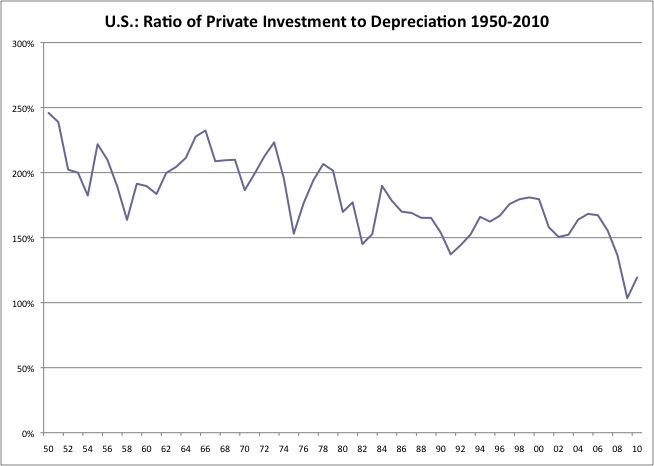
As you can see, in the happy 1950s and 1960s, the investment/depreciation ratio was around 200%. There was a lot of investment in new capacity. During the 1980s and 1990s, this drops somewhat. Today, it has reached the lowest postwar levels, which is why you don’t see employment picking up.

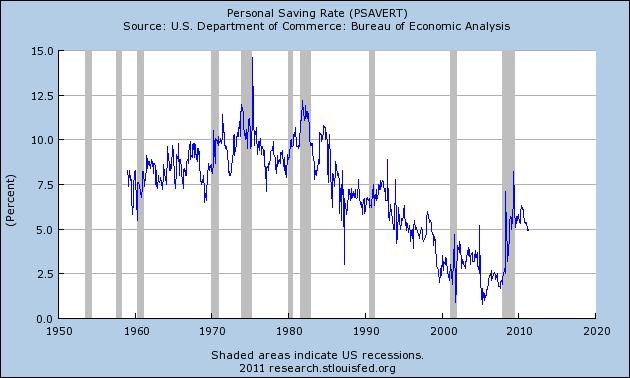
Falling savings rate means less capital creation.
A similar thing has happened in Japan.
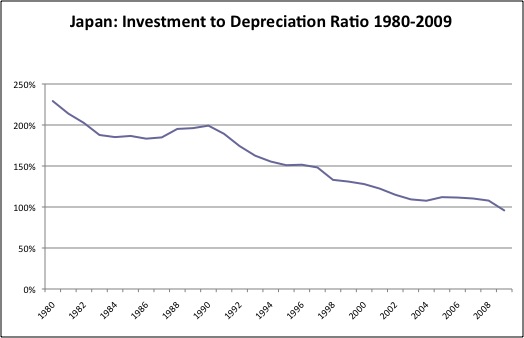
Again, we see a very high ratio during the prosperous 1980s, and a steady decline since then.
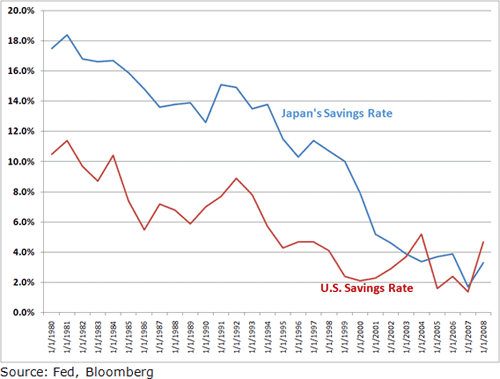
Japan used to be kicking the U.S.’s butt. Not so much anymore.
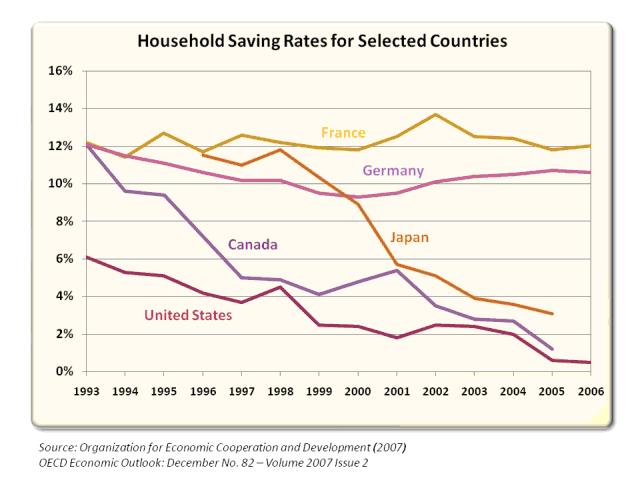
We critcize Europe’s supposedly high tax/low growth environment, and yet, it is not at all obvious that the U.S. economy is doing better than that of Europe, or that the U.S. worker is better off. This is in part because Europe has more capital creation, and also much lower taxes on capital. The U.S. has some of the highest taxes on capital in the world.
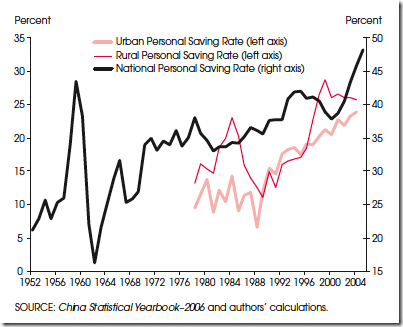
China has absolutely enormous capital creation these days. The overall savings rate is in the neighborhood of 50%!

There are lots and lots of people who used to use shovels that are now being given backhoes (this is literally true in China). Also, they are building a lot of nice hotels.
Look again at the U.S. population figures above. We see a significant decline in population growth beginning around the 1920s. This makes labor relatively more scarce. Combined with high levels of investment (in the 1950s and 1960s), and not too much competition from emerging markets in those days (China was communist, shipping and information systems a lot less sophisticated), we have a relatively comfortable period for labor during those postwar decades.
Today, not so nice.
This really just scratches the surface of the many, many topics related to the capital/labor ratio. I will talk about it more in the future — I hope sooner than three years from now.
But, I think you can get a sense of why an environment that favors capital — basically, Low Taxes and Stable Money, plus a certain modicum of business-friendly regulation, a stable political environment, a reliable judicial system and so forth — thus favors capital creation, investment, and consequently higher wages, less income disparity, and lower unemployment.
You could say that the 19th Century capitalist environment represented an excessive reliance upon capital creation to solve problems of unemployment, wage disparity and so forth. They had a low tax/stable money environment, but they didn’t have any other solution except for “get a job.” The 20th Century capitalist environment, especially after 1970, represented an excessive reliance upon government welfare services, government jobs, monetary fiddling etc. to solve the same problems, almost completely ignoring the importance of capital creation and the capital/labor ratio to produce these outcomes (Reagan and Thatcher helped correct this to some degree). They didn’t have any solution except for “welfare spending/create more government jobs.” I have an idea of “21st Century Capitalism” in which we want to ramp up the capital creation machine as much as possible, thus creating as many high wage/high productivity jobs as possible with the lowest unemployment, but also keep the best parts of the various government services that have developed during the 20th Century, such as universal healthcare, universal primary and secondary education, some form of public pension or at least income insurance for seniors, unemployment insurance, and so forth.
January 12, 2011: Moving Toward 21st Century Capitalism
We are already close to that idea in the U.S., at least at the intellectual level. Just as the Great Depression served as the crisis which cleared out the status quo in the U.S. and allowed for the introduction of the 20th Century welfare state, an idea that had been discussed throughout the second half of the 19th century, thus also today’s crisis, which includes the bankruptcy of the Welfare State due to excessive expenditures and debt, may eventually lead to the implementation of these ideas. Look, for example, how the recent U.S. debt ceiling talks, normally an occasion of minor spending cuts and incremental tax hikes, have strangely turned into a discussion of major tax reform, with top rates lowered to around 26% for individuals and corporations. The Heritage Foundation has produced a rather good report on solving the U.S. debt problem, which includes many of these ideas.
Click here for Heritage Foundation report “Saving the American Dream.”

